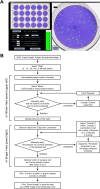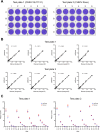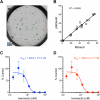Development of an automated plaque-counting program for the quantification of the Chikungunya virus
- PMID: 40217093
- PMCID: PMC11992114
- DOI: 10.1038/s41598-025-97590-3
Development of an automated plaque-counting program for the quantification of the Chikungunya virus
Abstract
Chikungunya virus (CHIKV) induces a massive cytopathic effect (CPE) on various cell types. Therefore, the plaque assay, a CPE-based virus titration method, remains the gold standard for quantifying the infectious units of CHIKV. However, manual plaque counting is often a labor-intensive task, especially in experiments involving multiple samples. In this study, we developed plaQuest, a stand-alone plaque-counting software running on a Windows operating system, for rapid and reliable quantification of CHIKV plaques in a 24-well plate. Our evaluation experiments using the conventional CPE-based plaque assay showed that the CHIKV plaque counts provided by plaQuest strongly correlated with the plaque counts manually determined by four analysts. In addition, the CHIKV inhibition curve of mycophenolic acid (MPA) determined by plaQuest was identical to that determined by manual counting, resulting in a similar 50% inhibitory concentration of MPA. Furthermore, the automated plaque counting by plaQuest was applicable to the evaluation of inhibitors against other RNA viruses using the CPE-based and immunostain-based plaque assay, which is an alternative titration assay for non- (or less) cytopathic viruses. Thus, our study demonstrates that plaQuest is an effective option for quantifying infectious virus titers, reducing the workload of the plaque assay.
© 2025. The Author(s).
Conflict of interest statement
Declarations. Competing interests: The authors declare no competing interests.
Figures






Similar articles
-
Development of a Real-Time Cell Analysing (RTCA) method as a fast and accurate screen for the selection of chikungunya virus replication inhibitors.Parasit Vectors. 2015 Nov 9;8:579. doi: 10.1186/s13071-015-1104-y. Parasit Vectors. 2015. PMID: 26553263 Free PMC article.
-
Cellular IMPDH enzyme activity is a potential target for the inhibition of Chikungunya virus replication and virus induced apoptosis in cultured mammalian cells.Antiviral Res. 2011 Jan;89(1):1-8. doi: 10.1016/j.antiviral.2010.10.009. Epub 2010 Nov 9. Antiviral Res. 2011. PMID: 21070810
-
Heterogeneity of clinical isolates of chikungunya virus and its impact on the responses of primary human fibroblast-like synoviocytes.J Gen Virol. 2018 Apr;99(4):525-535. doi: 10.1099/jgv.0.001039. Epub 2018 Mar 8. J Gen Virol. 2018. PMID: 29517478
-
Mefenamic acid in combination with ribavirin shows significant effects in reducing chikungunya virus infection in vitro and in vivo.Antiviral Res. 2016 Mar;127:50-6. doi: 10.1016/j.antiviral.2016.01.006. Epub 2016 Jan 18. Antiviral Res. 2016. PMID: 26794398
-
Chikungunya virus infections: time to act, time to treat.Curr Opin Virol. 2017 Jun;24:25-30. doi: 10.1016/j.coviro.2017.03.016. Epub 2017 Apr 14. Curr Opin Virol. 2017. PMID: 28414993 Review.
References
-
- Condit, R. C. Principles of virology. In Fields Virology, 5th edn (eds Knipe, D. M. & Howley, P. M.) Vol. I 25–57 (Lippincott Williams & Wilkins, 2007).
-
- The Science of Virology. In Principles of Virology: Molecular Biology, Pathogenesis, and Control 29–31 (eds Flint, S. J., Enquist, L. W., Krug, R. M., Racaniello, V. R. & Skalka) (ASM, 2000).
-
- Weaver, S. C. & Lecuit, M. Chikungunya virus and the global spread of a mosquito-borne disease. N Engl. J. Med.372, 1231–1239 (2015). - PubMed
-
- Couderc, T. & Lecuit, M. Chikungunya virus pathogenesis: From bedside to bench. Antiviral Res.121, 120–131 (2015). - PubMed
MeSH terms
Substances
Grants and funding
LinkOut - more resources
Full Text Sources
Medical
Research Materials
Miscellaneous

